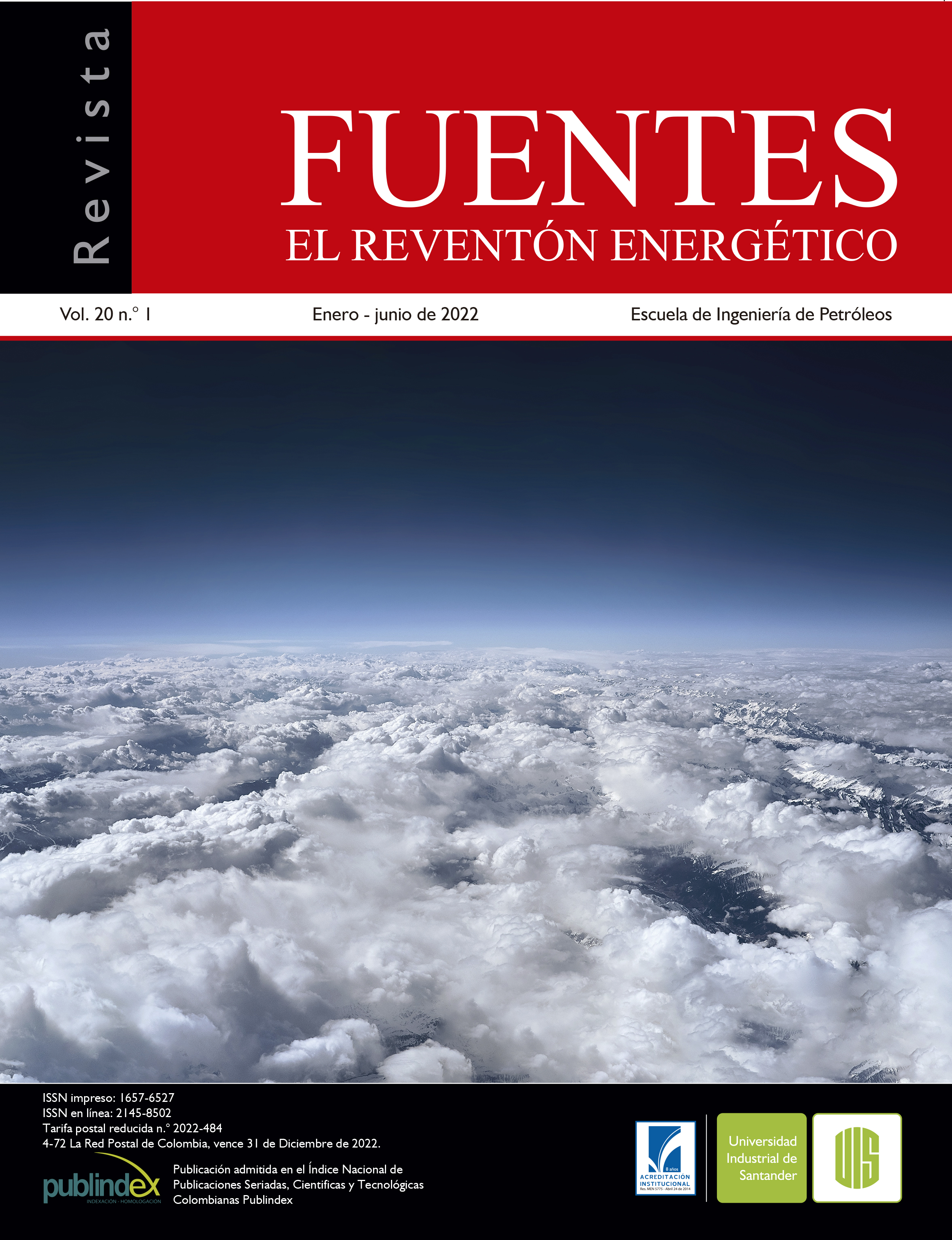Effect Dynamic Fluid of a new configuration of a nozzle of the bit PDC about the pressure differential
Published 2022-06-30
Keywords
- Computational Fluid Dynamics,
- Drill Bit,
- Drilling,
- Non-Newtonian Fluid,
- Overbalance Drilling
- Underbalanced Drilling,
- Dynamic Underbalanced Drilling ...More
How to Cite
Copyright (c) 2022 Escuela de Petróleos, Universidad Industrial de Santander

This work is licensed under a Creative Commons Attribution 4.0 International License.
Abstract
Operational costs associated with oil extraction have risen significantly over the past 10 years. In addition, it has been shown that oil price fluctuations have represented a challenge for oil companies that have to search for strategies to improve the performance of each process associated with hydrocarbon exploration, such as well planning and drilling (Amer et al., 2017). Research in this field aims to reduce drilling time. To achieve this goal the optimization of drilling parameters is necessary including mud behavior, well integrity, and bit performance to improve the rate of penetration (ROP). (Mohammed et al., 2018). Bit performance represents a key factor in drilling improvement and reduction of associated costs. Through modifications in the body, cutters, or nozzles, about conventional bits, better performance can be achieved from a technical and financial point of view. This study focuses on analyzing the effect of the modification of the nozzle angle for a PDC drill bit through the simulation of the mud behavior using Computational Fluid Dynamics. Results show that modifications of ninety degrees in nozzle angle manage to reduce the output pressures from the drill bit to differentials of up to 1200 psi; this has been generated between the formation and the outlet of the nozzles, allowing a low balance state between the drill bit and the well, which contributes to the increase of the ROP.
Downloads
References
- Aadnoy, B., Cooper, I., Miska, S., Mitchell, R. F., & Payne, M. L. (2009). Advanced Drilling and Well Technology. Society of Petroleum Engineers.
- Amer, M. M., Dahab, A. S., & El-Sayed, A.-A. H. (2017, abril 24). An ROP Predictive Model in Nile Delta Area Using Artificial Neural Networks. SPE Kingdom of Saudi Arabia Annual Technical Symposium and Exhibition. https://doi.org/10.2118/187969-MS
- American Petroleum Institute. (2001). Manual de fluidos de perforación. Dallas, Texas.
- ANSYS, Inc. (2009, enero 29). ANSYS FLUENT 12.0 User’s Guide—8.4.5 Viscosity for Non-Newtonian Fluids. ANSYS FLUENT User’s Guide. https://www.afs.enea.it/project/neptunius/docs/fluent/html/ug/node297.htm#fig-nn-hb
- Ayala, D., Benítez, A., & Valencia, R. (2017). Optimización de la Tasa de Penetración mediante el análisis de las vibraciones al perforar, caso de estudio Ecuador. Revista Fuentes, el reventón energético, 15(1), 27-40. https://doi.org/10.18273/revfue.v15n1-2017003
- Batchelor, G. K. (2000). An Introduction to Fluid Dynamics (Cambridge Univ.Press). http://adsabs.harvard.edu/abs/2000ifd..book.....B
- Caenn, R., Darley, H. C. H., & Gray, G. R. (2017). Chapter 10—Drilling Problems Related to Drilling Fluids. En R. Caenn, H. C. H. Darley, & G. R. Gray (Eds.), Composition and Properties of Drilling and Completion Fluids (Seventh Edition) (pp. 367-460). Gulf Professional Publishing. https://doi.org/10.1016/B978-0-12-804751-4.00010-9
- Cárdenas, C. A., Sánchez Martínez, J. J., Ariza León, E., & Machuca Boada, W. (2013). Análisis reológico para predecir y mejorar el comportamiento hidráulico durante la perforación de un pozo. Revista Fuentes, el reventón energético, 11(1), Article 1. https://revistas.uis.edu.co/index.php/revistafuentes/article/view/3613
- Hamme, J. (2014). CFD Modeling of Mud Flow around Drill Bit [Lulea University of Technology]. http://www.academia.edu/15789875/MASTERS_THESIS_CFD_Modeling_of_Mud_Flow_around_Drill_Bit
- Hamne, J. (2014). CFD Modeling of Mud Flow around Drill Bit. http://urn.kb.se/resolve?urn=urn:nbn:se:ltu:diva-49453
- Jiménez De la Ossa, K. J., Gonzalez Silva, G., Prieto Jimenez, N., & Saavedra, N. (2019a). Análisis del efecto de una modificación en el ángulo de boquillas para una Broca PDC aplicando Dinámica de Fluidos Computacional. Universidad Industrial de Santander.
- Jiménez De la Ossa, K. J., Gonzalez Silva, G., Prieto Jimenez, N., & Saavedra, N. (2019b). Análisis del efecto de una modificación en el ángulo de boquillas para una Broca PDC aplicando Dinámica de Fluidos Computacional. Universidad Industrial de Santander.
- Lozano, V., Rivas Hoyos, D., Loza, J., Suárez, D., & Calderón, Z. (2011). METODOLOGÍA PARA LA SELECCIÓN DE POZOS CANDIDATOS A PERFORAR EN CONDICIONES DE BAJO BALANCE. APLICACIÓN AL CAMPO CASTILLA DE ECOPETROL S.A. Revista Fuentes, el reventón energético, 9(2), Article 2. https://revistas.uis.edu.co/index.php/revistafuentes/article/view/2615
- Montes, A., Carreño, W., & Guío, M. (2018). Aspectos de la perforación de pozos complejos en piedemonte en tiempos de crisis. Revista Fuentes, el reventón energético, 16(1), 87-97. https://doi.org/10.18273/revfue.v16n1-2018008
- Murray, A. S., & Cunningham, R. A. (1955). Effect of Mud Column Pressure on Drilling Rates. Transactions of the AIME, 204(01), 196-204. https://doi.org/10.2118/505-G
- Neiri, E., H, M., Dahab, A. S. A., & Abdulaziz, A. M. (2016, enero 26). The Dynamic Underbalanced Drilling: A New Drilling Technique. SPE/IADC Middle East Drilling Technology Conference and Exhibition. https://doi.org/10.2118/178153-MS
- Ochoa, D. M., Vivas, J., & Santafé Rangel, E. R. (2009). USO DEL MÉTODO DE ELEMENTOS FINITOS (MEF) PARA LA DETERMINACIÓN DE ESFUERZOS Y DEFORMACIONES EN UN MODELO DE POZO. Revista Fuentes, el reventón energético, 7(1), Article 1. https://revistas.uis.edu.co/index.php/revistafuentes/article/view/360
- Petitjean, L., & Couet, B. (1994, enero 1). Modeling of fracture propagation during overbalanced perforating. SPE Annual Technical Conference and Exhibition. https://doi.org/10.2118/28560-MS
- Robinson, L. (2010). Drill Bit Nozzle Pressure Loss. AADE-10-DF-HO-26. AADE Fluids Conference and Exhibition, Houston, Texas.
- Rodi, W. (2017). Turbulence Models and Their Application in Hydraulics. Routledge. https://doi.org/10.1201/9780203734896
- Sagaut, P. (2006). Large Eddy Simulation for Incompressible Flows: An Introduction. Springer Science & Business Media.
- Vidrine, D. J., & Benit, E. J. (1968). Field Verification of the Effect of Differential Pressure on Drilling Rate. Journal of Petroleum Technology, 20(07), 676-682. https://doi.org/10.2118/1859-PA
- Welahettige, P., Lundberg, J., Bjerketvedt, D., Lie, B., & Vaagsaether, K. (2020). One-dimensional model of turbulent flow of non-Newtonian drilling mud in non-prismatic channels. Journal of Petroleum Exploration and Production Technology, 10(2), 847-857. https://doi.org/10.1007/s13202-019-00772-9
- Xamán, J. (2016). Dinámica De Fluidos Computacional Para Ingenieros. Palibrio.
